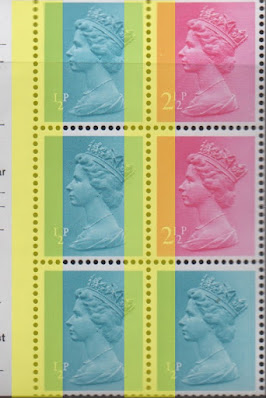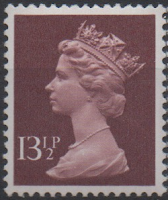As we know, there has been plenty to study with those, even with most of them being NVIs there have been different year codes, source codes, colour changes, backing paper changes, etc which has kept collectors interested.
In the 1970s we didn't have those varieties but there was a lot of variation in head type, gum, paper type, and phosphor. Also for some values the location of the denomination varied especially in relation to the head.
I was reminded of all this when I came to prepare my earlier Machins for Royal Mail's Swap-Out scheme - or for earlier sale. In this and further posts I shall explore some of the differences which are easy to see with the naked eye.
Catalogues - but which?
Aside from the very large number of stamps, one of the problems now for the new collector of earlier issues, is the multiplicity of catalogues some very much more complex than others. All useful up to a certain period, and some for the whole period, most ask too much of the collector - or assume too much.
The Machin Collctors Club catalogue, to take one example at random, is excellent if you know what you've got. It even has some useful aids to identifying what you have (papers, gums etc by a process of elimination). But the section on single stamps is separated into singles from sheets (subdivided by paper and gum), then booklets (ditto), then coils (ditto), rather than by value, which is where the collector starts.
Before the catalogues
In the 1970s and 80s in the UK we had the benefit of Stamp Collecting Weekly which didn't have the long lead times that modern monthlies do, and provided a great deal of timely news every week, whether emanating from the GPO, from specialist collectors/dealers, or from readers who were reporting their 'finds'.
So we were told about variations which were very easy to find and to collect - and waited until later to see what the catalogue editors decided to do!
In this post I explore some of the phosphor variations.
15 February 1971 - whether we managed to get the stamps on the proper day of issue or when the Postal Strike was over, the first unexpected variant came with the first low values. As well as 12 values to 9p there were booklets - stitched not folded - containing panes of 4, 5 or 6 stamps.
The 50p book contained 10@ 3p, 5@ ½p, and 7@ 2½p. As well as containing panes of 6 stamps or 5 and a label, one pane contained 4@ 3p and 2@ 2½p - the latter having a single phosphor band at the left.
 |
| Pane SG X852L from 50p booklet 1971. |
So immediately there was a second variation of the 2½p stamp to collect - and easily obtainable*. Incidentally, the image deliberately shows part of another pane: booklet pane collectors could also find a variety of different finishes to the panes, with properly guillotined, roughly cut, and perforated binding edges. There were also variations in the central horizontal row of perforations, as shown, with some margins being perforated right through, and some not.
* Easily obtainable, but not always easy to find with full perforations. Adjacent to this pane was another identical but inverted pane, the booklets being assembled stitched and then guillotined leaving some poor perforations, some adequate for collection, and some full holes+. This applied to all three sides of the pane. Finding a 'good' example was more difficult than finding a bad one!
(I would like to show actual photographs of phosphor bands and reaction but as the main equipment I used for earlier photos has broken, and is no longer available, I shall rely on graphic overlays on scanned images instead.)
Wedgwood £1 Book
The following year, on 24 May 1972, the second Sponsored Stamp Book was produced, the Wedgwood £1 book. (The first was the pre-decimal Milk Marketing Board book.) This contains a mix of 1st and 2nd class (6@ 3p & 17@ ½p (7) as make-weights for the difference and to make up the £1 face value.
The 2½p stamps are a mix of centre band, left band, and right band, but the final pane contained 2@ 2½p and 4@ ½p arranged in a 2 x 3 block. With the normal ½p having two bands, and the 2½p having one, the format was similar to the pane above, but it left one ½p stamp with only a single band at the left. When this was reported it was sought after, and finding it with complete perforations on the two cut sides proved difficult. Although the price has varied over 50 years, it is still one of the most expensive non-error Machins.
 |
| Pane 4 from £1 Wedgwood sponsored book, 1972. |
I was going to add Machine Vended Booklets here, but as Royal Mail have now unblocked the despatch of international mail, I will hold those over for a later post.
All these stamps are prefixed X- by Stanley Gibbons, and many of the unlisted are available for sale in our recent List 7.
More to come soon!

















I have fond memories of those times with postal needs necessitating the Machin varieties and half a dozen modest sets of "special stamps" each year earning what they deserved from collectors.
ReplyDelete